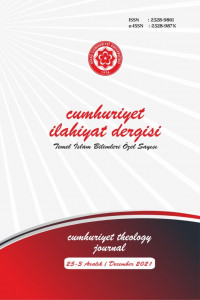Mu‘tezile-Şîa Etkileşimi Bağlamında Zemahşerî’nin Hz. Ali Hakkında Nazil Olduğu Nakledilen Âyetlere Yaklaşımı
Al-Zamakhsharī’s Approach to the Verses Reported to be About ʿAlī b. Abī Ṭālib in the Context of Mu‘tazila- Shīʿa Interaction
Author(s): Ersin ÇelikSubject(s): Semiotics / Semiology, Islam studies, Semantics, Philosophy of Religion, History of Islam, Qur’anic studies
Published by: Cumhuriyet Üniversitesi İlahyat Fakültesi
Keywords: Tafsīr; Interaction; Mu'tazila; Shīʿa; Ahl al-Bayt; ʿAlī b. Abī Ṭālib; Al-Zamakhsharī; Al-Kashshāf;
Summary/Abstract: Mu'tazila and Shīʿa (Zaydiyya-Imāmiyya) have common views on many theological issues except the imamate. This issue has been generally accepted by other Islamic scholars rather than Shīʿa and by Western researchers. That in this interaction between the Mu‘tazila and the Shīʿa, the Shīʿa is the side mostly affected. However, it is an issue that should not be overlooked that the Shīʿa partially influenced the Mu'tazila in ʿAlī b. Abī Ṭālib, over the other Companions. In this context, some persons from the Baghdad Mu’tazila School such as Bishr b. al-Muʿtamir (d. 210/825), Jaʿfar b. Mubashir (d. 234/848), Jaʿfar b. Harb (d. 236/850) and al-Iskāfī (d. 240/854) argued that the imamate of Abū Bakr, who was less virtuous, was permissible although they considered ʿAlī as the most virtuous person after the Prophet. In addition, al-ʿAllāf (d. 235/849-850), al-Naẓẓām (d. 231/845), Abū Abdullah al-Basrī (d. 369/979- 80) and Qāḍī ʿAbd al-Jabbār (d. 415/1025) along with Abū ʿAlī al-Jubbāʾī (d. 303/916), one of the chiefs of the Basra Mu'tazila School, and Abū Hāshim al-Jubbāʾī (d. 321/933) did not accept the order of caliphate as the order of virtue. This study focuses on the issue of whether the aforementioned affinity between Mu'tazila and Shīʿa affected Mu'tazila, especially in the interpretation of the verses associated with ʿAlī. In the study, the aforementioned problem was examined through the tafsīr al-Kashshāf of the Muʿtazilī mufassir al-Zamakhsharī (d. 538/1144). In addition to the importance of tafsīr, the fact that al-Zamakhsharī took lessons from Shīʿīte/Zaydī persons and he wrote the tafsīr with the support of Zaydī leader al-Wahhās (d. 506/1112) is effective in handling this issue through al-Kashshāf's tafsīr. In the first part of the study, first of all, the interaction between Imāmiyya and Zaydism, which are the two most important branches of Mu‘tazila and Shīʿa, is briefly mentioned. Then, Mu'tazila’s and Al-Zamakhsharī’s view on ʿAlī's position among other caliphs is emphasized. Al-Zamakhsharī, who is from the Basra school of the Mu'tazila, does not consider ʿAlī b. Abī Ṭālib superior to Abū Bakr, unlike al-ʿAllāf, Abū ʿAlī al-Jubbāʾī, Abū Hāshim al-Jubbāʾī and Qāḍī ʿAbd al-Jabbār, who are the leading figures of this school. In fact, the fact that he always observed the order of the caliphate while talking about the merits of the four caliphs supports the possibility that, unlike his predecessors, he accepted the order of the caliphate as the order of virtue. In the second part, it is questioned whether the narrations that al-Zamakhsharī included in his tafsīr of the verses associated with ʿAlī are similar to the narrations of the Shīʿīte/Zaydī/Imāmī tradition and whether he interpreted the verses in parallel with these narrations. In this respect, the tafsīr al-Kashshāf has been examined comparatively with the Sunni and Shiite tafsīrs prior to it. Eventually, while interpreting these verses associated with the Ahl al-bayt (members of the Prophet’s household), al-Zamakhsharī highlights the narrations that appreciate the virtues of ʿAlī b. Abī Ṭālib and his child. However, he also refrains from making comments that would be in line with the Shīʿa's belief in imamate. In particular, his tafsīr of the verse al-Aḥzāb 33/33 in the context of the Prophet’s wives is the greatest indicator of this situation. It has been determined that while al-Zamakhsharī includes the narrations highlighting the virtue of ʿAlī b. Abī Ṭālib and his children, he mostly follows the Sunni commentator al-Thaʿlabī. In particular, it has been seen that al-Zamakhsharī transferred the narration material in the interpretation of the relevant verses from al-Thaʿlabī's commentary almost in the same way. However, it is noteworthy that al-Zamakhsharī differs from him in some details such as linguistically supporting these narrations in some verses such as ʾĀli ʿImrān 3/61 and al-Māʾidah 5/55. An indirect influence can be mentioned because al-Thaʿlabī frequently narrates the narrations supporting the Shīʿītes in places where there is a Sunni-Shīʿīte conflict. Therefore, although there is no evidence that al-Zamakhsharī took these narrations from Shīʿīte sources, it is seen that he brought ʿAlī b. Abī Ṭālib-based narrations in Sunni sources into the fore. Even in the commentary of al-Ḥākim al-D̲ h̲ us̲h̲ amī, al-Zamakhsharī's teacher in the line of Zaydi/Mu'tazili, the lack of Ali emphasis in the interpretation of the aforementioned verses supports our view.
Journal: Cumhuriyet İlahiyat Dergisi
- Issue Year: 25/2021
- Issue No: 3
- Page Range: 1123-1142
- Page Count: 20
- Language: Turkish

